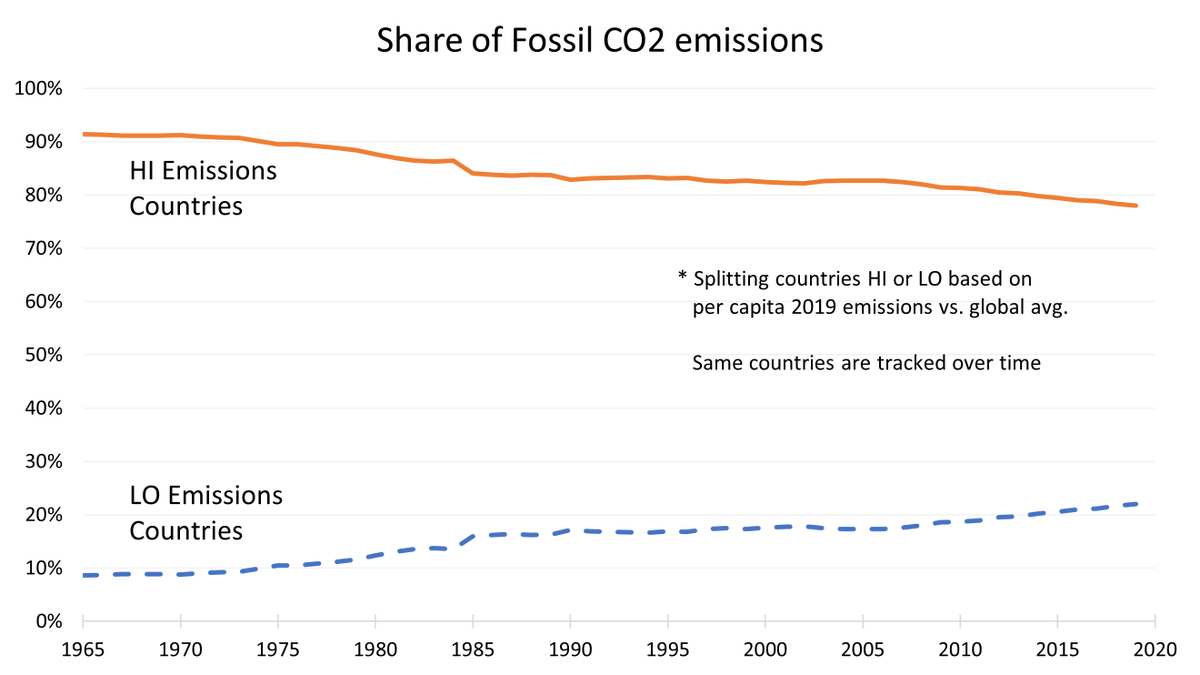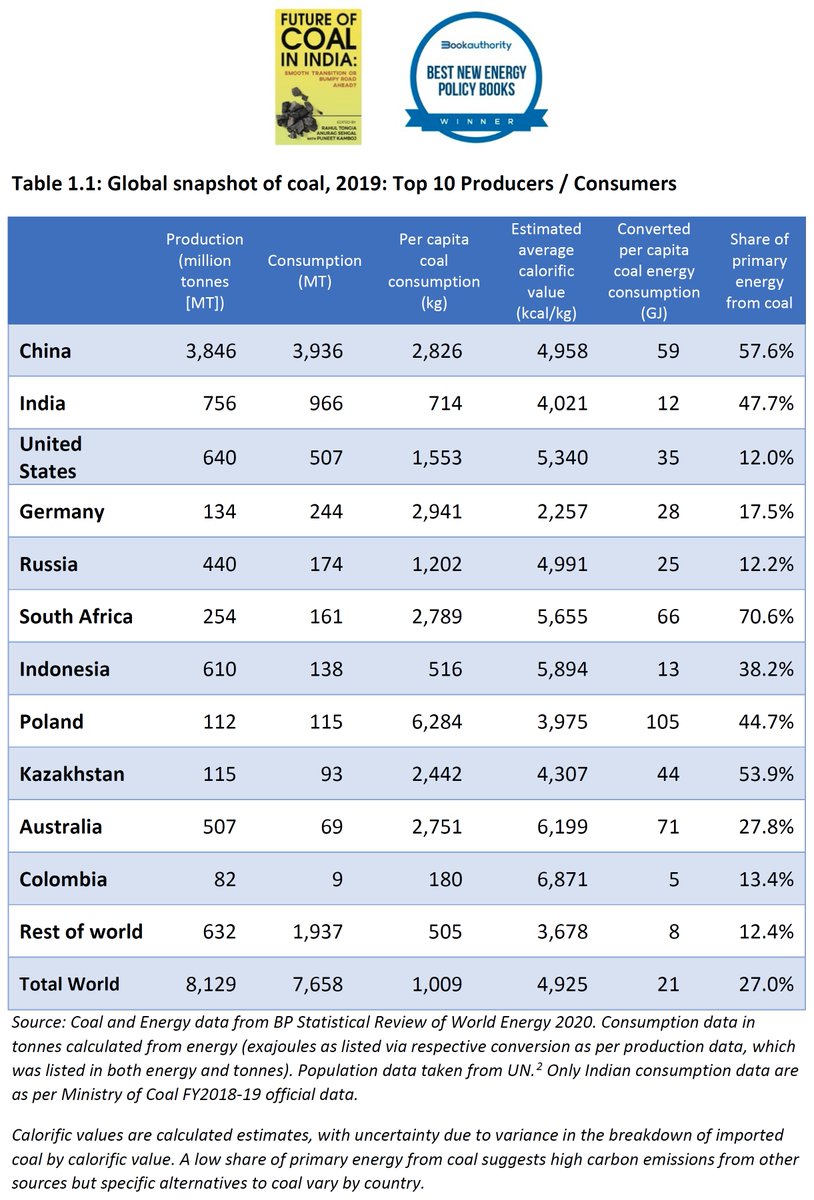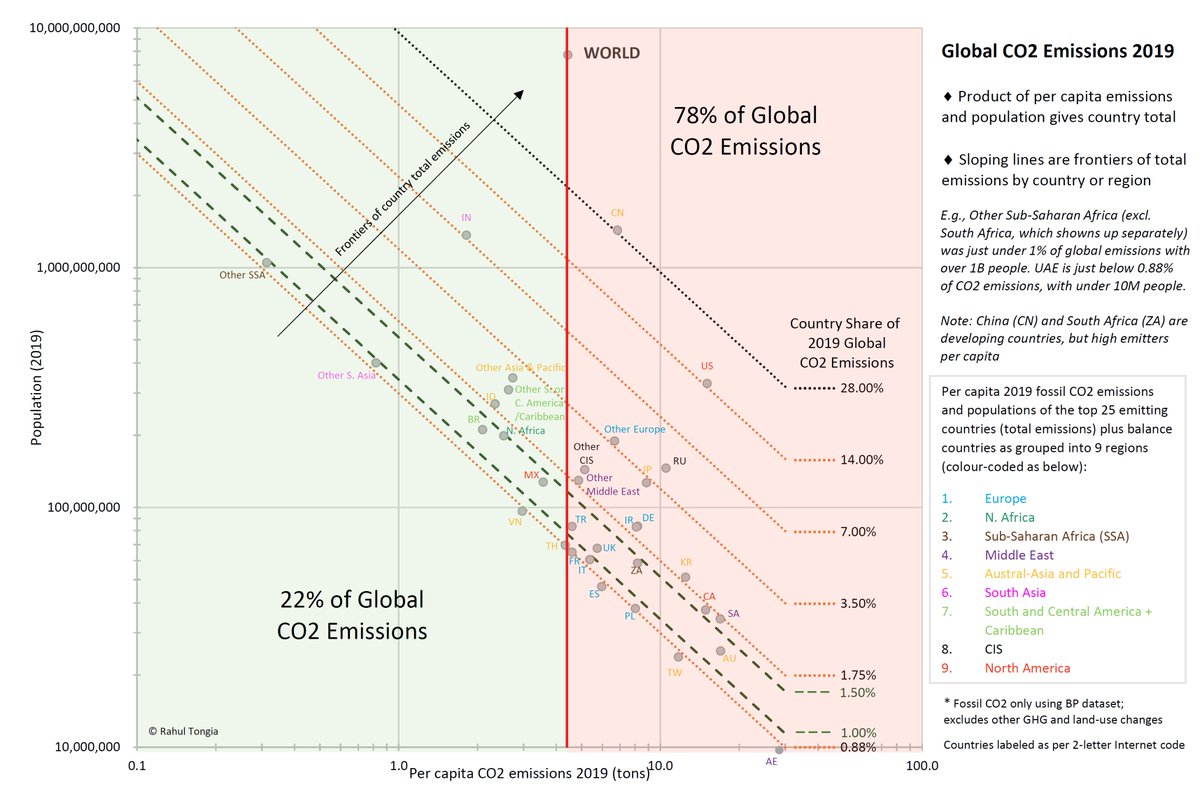As US convenes a Climate Summit, are developing regions a distraction from where the real action should be: emissions from HI emitters?
LDCs should focus on 1) electrification, regardless of fuel 2) slowing C growth & peaking lower 3) avoiding lock-ins. https://www.hindustantimes.com/analysis/in-the-climate-battle-focus-on-the-highemitters-101619002722928.html">https://www.hindustantimes.com/analysis/...
LDCs should focus on 1) electrification, regardless of fuel 2) slowing C growth & peaking lower 3) avoiding lock-ins. https://www.hindustantimes.com/analysis/in-the-climate-battle-focus-on-the-highemitters-101619002722928.html">https://www.hindustantimes.com/analysis/...
The real problem isn’t rising emissions from the poor, it’s lack of reductions from high-emitters (mostly the rich).
It’s worse than the graph shows. The High Emitters’ *share* is falling, but absolute emissions are still rising (0.79% annually till & #39;19).
{photo tags are cc}
It’s worse than the graph shows. The High Emitters’ *share* is falling, but absolute emissions are still rising (0.79% annually till & #39;19).
{photo tags are cc}
Developed countries: “Why should we do anything when developing regions will emit more than us?”
This is FALSE.
Increase from HI emitters over last 15 yrs > increase from LO emitters.
Conveniently also ignores per capita or past emissions. https://www.nationalobserver.com/2020/02/28/opinion/what-about-china-and-india">https://www.nationalobserver.com/2020/02/2...
This is FALSE.
Increase from HI emitters over last 15 yrs > increase from LO emitters.
Conveniently also ignores per capita or past emissions. https://www.nationalobserver.com/2020/02/28/opinion/what-about-china-and-india">https://www.nationalobserver.com/2020/02/2...
Let’s compare trajectories & requirements. If HI emitters& #39; ref = decline to zero in 30 yrs, their *failure to reduce* over last 10 yrs was greater than the future continued rise from LO emitters (at present rates of rise). By the time many LDCs grow, technology will decarbonize.
Emissions from the poorest are a rounding error.
A Billion people supplied coal-based electricity (35 kWh/month/home =TV, fan, fridge) =0.25% of global emissions. The push to "leapfrog to RE" distracts from their real need: access.
Good news: Electricity is easy to decarbonize.
A Billion people supplied coal-based electricity (35 kWh/month/home =TV, fan, fridge) =0.25% of global emissions. The push to "leapfrog to RE" distracts from their real need: access.
Good news: Electricity is easy to decarbonize.
I’m no coal apologist, but while we rush to end coal (used disproportionately in developing regions), financiers still funds lots of oil & gas. Half the coal was used in China. India was #2, but India’s per capita consumption (normalized for C content) was ½ the world 2019 avg.
Zero by 2050 is usually “net-zero”, relying on offsets. Many of these are accounting tricks; some rely on unproved or at least expensive technology in the distant future. Also, many offsets unfairly rely on developing regions. https://www.theguardian.com/commentisfree/2021/mar/03/climate-crisis-carbon-accounting-tricks-big-finance">https://www.theguardian.com/commentis...
Why are offsets unfair? Some folks claim “all carbon is equal” (then what about historical emissions?) but the economics are NOT equal. Developed countries should clean up their tail end of emissions, which is expensive. Some offsets should also accrue to the developing country.
It would be naïve/impractical to expect meaningful emissions trajectory shifts downwards by developing regions without massive support: technology and finance. We& #39;re nowhere near the $100B by 2022 support by developed countries pledged at COP15.
Unfortunately, “Climate Finance” has also involved accounting tricks, often including loans for renewable energy projects, some of which are simply the new BAU. We need additional & permanent displacement of carbon at the least. https://www.nature.com/articles/d41586-020-03481-0">https://www.nature.com/articles/...
Net-zero by 2050 doesn’t mean everyone 0 simultaneously. 30 yrs decline to 0 = high emitters will still over-emit & low emitters won’t emit much (compared to *remaining* carbon budget allocated by popn).
BTW, China& #39;s emissions were 50% > avg per capita. India’s were < ½ the avg.
BTW, China& #39;s emissions were 50% > avg per capita. India’s were < ½ the avg.
High popn in LDCs? Their per capita C is so low that total C is still low. Take the lowest 3 per capita: Sub-Saharan Africa (excl ZA), India, and Other S. Asia. Total emissions just 9.2%, for 36.5% of world’s popn.
Flip: top 20% of world popn. responsible for half the emissions.
Flip: top 20% of world popn. responsible for half the emissions.
BUT developing regions shouldn’t get a pass to ignore C; they will be the most vulnerable to its impacts.
+ These changes represent an opportunity for equitable energy futures (& lots of economic activity). They should also introspect if their C space is used up by their elites.
+ These changes represent an opportunity for equitable energy futures (& lots of economic activity). They should also introspect if their C space is used up by their elites.
Common But Differentiated Responsibilities should convert to Universal But Different Action. HI emitters need to come down immediately & to true zero ASAP. LO emitters have to decouple GDP and carbon, and avoid carbon-locking pathways.
We all need to do as much as we can!
We all need to do as much as we can!
(Pl. read the full OpEd before yelling at me)
cc& #39;ing a few folks on #energytwitter and #ClimateTwitter for joining this perhaps unpopular (but inconveniently real) issue.
@JasonBordoff @jurpelai @MBazilian @ThomasASpencer @deepalikhanna @busbyj2 @samanthaenergy @globalsarang
cc& #39;ing a few folks on #energytwitter and #ClimateTwitter for joining this perhaps unpopular (but inconveniently real) issue.
@JasonBordoff @jurpelai @MBazilian @ThomasASpencer @deepalikhanna @busbyj2 @samanthaenergy @globalsarang

 Read on Twitter
Read on Twitter




